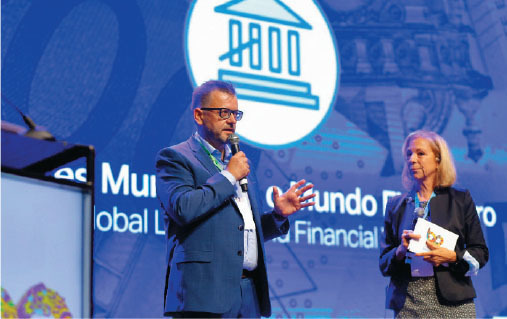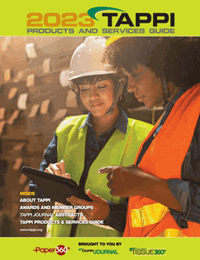
At last, a chance to get on a plane! Actually, not one plane, but six in total to make the return journey from London to the city of Belém, Pará State, northern Brazil. The city and state are of significant importance to the global bioeconomy as it is considered a “gateway to the Amazon,” one of the most important regions of the world when discussing climate change, sustainability, and deforestation.
There was an excellent turnout to the forum, both in-person and online, with some 400 delegates attending the sessions on site and more than 900 online—proving that, despite the pandemic, people are keen to find out how all types of industries can contribute when it comes to the mitigation of climate change. And it was great to see the representation of the pulp and paper industries, both in the panels and in the audience—proof that these industries have a major role to play in the challenges facing the planet right now.
FOUR PILLARS
This is the first time the forum has moved outside of its usual home, Ruka, in northern Finland. This was due to the fact that—according to founder of the forum Jukka Kantola—”no one bioeconomy fits all; every region has its own particular bioeconomy.” The forum operates under a four-pillar structure, which ensures that all areas of the bioeconomy are covered and that they all have a voice and a platform. The four pillars are: The Bioeconomy: People, Planet, Policies; Corporate Leaders and the Financial World; Bioproducts Around Us; and Looking to the Future.
Using the four pillars, the forum deals with bioeconomy issues from top to bottom—from government policies and strategies through to corporate and financial leadership, across the bioproduct industries, and finally to innovation and education. The pulp and paper industries were particularly well-represented on the CEO panel in the Corporate Leaders section, with appearances by Cristiano Teixeira, CEO of major Brazilian paper and packaging producer Klabin; Joachim Schönbeck, board member and incoming CEO of technology supplier Andritz; and Celso Tacla, CEO Latin America, Valmet, also a technology supplier.
The panel discussion, moderated by Teresa Presas, industry consultant and former director general of the Confederation of European Paper Industries (CEPI), also included Dr. João Paulo Ferreira, CEO of Natura & Co.; and Dr. Sara Boettiger, head of global public affairs, science, and sustainability, Bayer.

Bioproducts from the Amazon were on display for Forum attendees.
CEO PANEL DISCUSSION
The panel discussion kicked off with a question from Presas covering the all-important issue of collaboration between all value chains, from forest to consumer and beyond, to ensure the creation of a successful bioeconomy. Klabin’s Teixeira responded, “This collaboration has to take place from the owners and investors all the way across to communities, suppliers, and peers. We are improving and getting better at it, but we are not there yet. There is so much more that can be done across the whole of the pulp and paper industries.
“The bioeconomy brings with it new challenges. For instance, we need scientists to help us come up with new barriers that will replace plastics, which have undoubtedly become very important to society due to their ability to keep food fresh,” Teixeira continued. “Plastic also has the advantages of being very light, something we are also working on at Klabin. Paper packaging can provide an alternative to plastic, but the reality is we need to speed this development up across the whole industry, worldwide.”

Forum founder Jukka Kantola (left) with panel moderator Teresa Presas. “The pulp and paper industry is the perfect role model for the circular bioeconomy in many aspects,” said Kantola.
DIGITALIZATION—MAKING A HUGE DIFFERENCE
The subject of speed of development also came up with Dr. Boettiger, who works in the field of crop science at life sciences company Bayer. The company is using some of the latest digital technology in its R&D, which is showing some remarkable results when it comes to efficiency.
Boettiger said, “We refer to what’s going on in our company right now as the ‘bio-revolution,’ which is the intersection between life sciences and digital technology. At Bayer, this is accelerating the speed of producing new vaccines, the production of lab-grown meat, and even the engineering of microbes to make aviation fuels. In our crop science area, all of our decisions are AI-driven where we combine details about genomes, plant traits, and environments. Implementation of AI means we can run these through much faster; our R&D teams are now leveraging more than two quadrillion calculations in cloud-based algorithms and things are moving very fast. R&D is now faster, which means more precise results and more predictable and more deliberate outcomes.
“But of course, it all comes down to planetary boundaries; everything has to be embedded and calculated. Yes, we need to grow more plants on less land in the future, but we also must calculate the results—for example, does lab-based meat have a better environmental footprint? That is what the bioeconomy is, we need to work within the planetary constraints.”
The digital transition also came up in the discussion panel with regard to the pulp and paper industry, and how the technology is making an impact when it comes to the bioeconomy. Tacla from Valmet LA said, “You cannot split these two subjects when it comes to the discussion we are having today. Digitalization means a lot of important areas of production in pulp and paper mills can now be monitored remotely, negating the need for engineers to travel long distances to improve processes or repair machines.
“Also, digitalization is making a huge impact when it comes to optimizing processes and improving performance at mills,” Tacla said. “This means we are enabling our customers to produce better products with less raw material and lower energy use. This is all part of the bioeconomy.”
DOWN TO ZERO
The pulp and paper industry in general has carried out a lot of work in the reduction of emissions over the years; however, work continues among suppliers to reduce them even further, in fact, down to zero. Dr. Schönbeck spoke on the panel about one of the company’s latest initiatives, CircleToZero.
“This initiative is perfectly in line with the bioeconomy, and at Andritz we feel we have a role in society: the role of providing technology that can bring solutions to our customers in their own sustainability efforts. CircleToZero has been launched to develop a completely waste- and emission-free pulp mill,” Schönbeck said. “We are aiming to eliminate all waste from side streams by either closing the loops completely or making a useful product out of them.
“This has had an amazing effect at Andritz. We have put together a group of young engineers and they really enjoy working for something with a real purpose. Most people in the industry know that a modern pulp mill is pretty much a closed loop already, but there is still a lot that can be done with innovation. With millions of tons of pulp and paper being produced each year, initiatives like this can make a real difference to our customers and then further on to society in general.”
Having carried out in-depth calculations on emissions, Valmet estimates that one percent of its emissions comes from its own operations, four percent from suppliers in the value chain, and 95 percent comes from its customers. The company launched its Sustainability 360° program in March, 2021, and created science-based targets to reduce its CO2 footprint as well as help its customers in their own efforts.
“We are working on a number of ways to reduce our own as well as our customers’ CO2 footprint,” Tacla said. “At Valmet, we have a target to reduce our energy use by 20 percent, and we have an ongoing R&D effort to assist our customers in reducing their own footprint. In fact, more or less half of our R&D budget is now being used to innovate environmental solutions.
“We are working on enabling our customers to produce 100 percent carbon neutral production, more than net zero to produce pulp and paper free of fossil fuel use. This is a boom area for us and we are already delivering technology that does exactly that. We have recently delivered a biomass gasifier plant to a customer in Latin America that will replace oil boilers in the lime kiln.”
THE REAL CHALLENGE: PROVIDING A CHOICE
Forum founder Jukka Kantola commented on the pulp and paper industries and their role in the bioeconomy, “The pulp and paper industry is the perfect role model for the circular bioeconomy in many aspects. The feedstocks are based on renewable and sustainable sources, the industry itself is showing high recycling rates, and in many cases cascading use is a driving force for valorization. And then of course there is the biodegradability of the end products.
“The World BioEconomy Forum is an exciting concept that is gaining interest from various stakeholders of the circular bioeconomy. Its four-pillar structure provides a comprehensive concept to evaluate and communicate the status of the bioeconomy. I think this is one reason that so many stakeholders, including CEOs of global major corporations, have an interest in taking part in our sessions.”
The trip down to Belem was a treat for the senses: great climate, sights, sounds, and tastes, but most of all it was enormously encouraging to see that the pulp and paper industries are being taken seriously as major players in the circular bioeconomy. We are moving into a world where consumers are looking to buy products that provide a solution to climate change. The challenge now is for suppliers and producers in the pulp and paper industries to give them that choice, as quickly as possible.
 Paper 360
Paper 360





